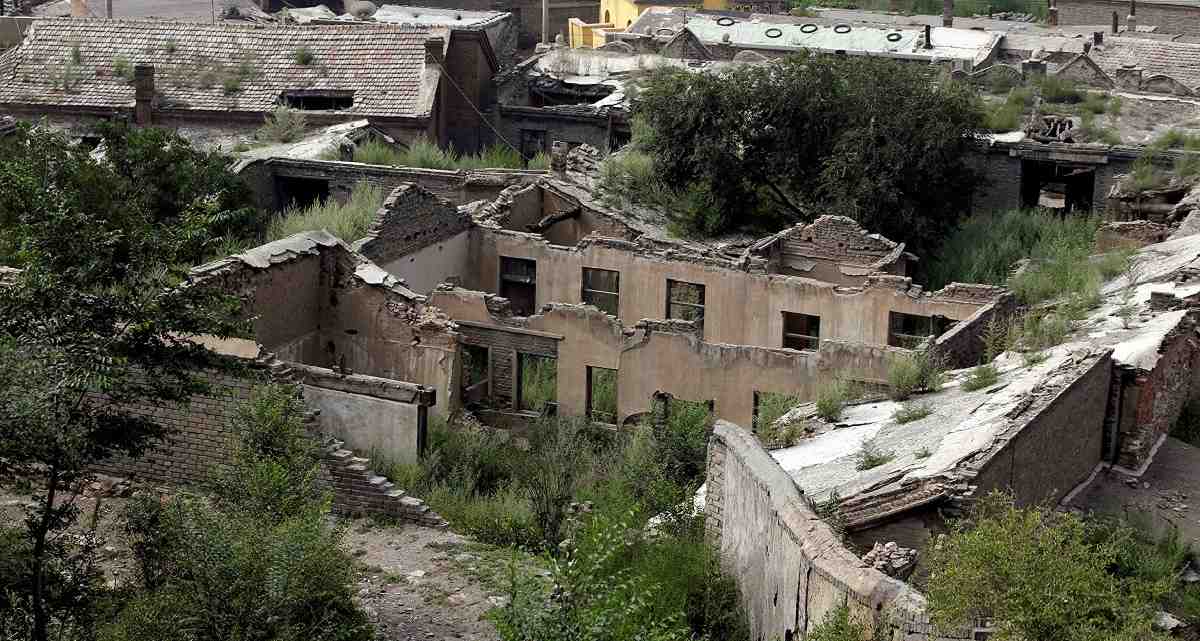
Abandoned houses are seen in an area where land is sinking near a coal mine in Kouquan township of Datong, China’s Shanxi province, August 1, 2016.
10:28 JST, April 19, 2024
SINGAPORE, April 19 (Reuters) – Nearly half of China’s major cities are suffering “moderate to severe” levels of subsidence, putting millions of people at risk of flooding especially as sea levels rise, according to a study of nationwide satellite data released on Friday.
The authors of the paper, published by the journal Science, found 45% of China’s urban land was sinking faster than 3 millimeters per year, with 16% at more than 10 mm per year, driven not only by declining water tables but also the sheer weight of the built environment.
With China’s urban population already in excess of 900 million people, “even a small portion of subsiding land in China could therefore translate into a substantial threat to urban life,” said the team of researchers led by Ao Zurui of the South China Normal University.
Subsidence already costs China more than 7.5 billion yuan ($1.04 billion) in annual losses, and within the next century, nearly a quarter of coastal land could actually be lower than sea levels, putting hundreds of millions of people at an even greater risk of inundation.
“It really brings home that this is for China a national problem and not a problem in just one or two places,” said Robert Nicholls at the Tyndall Centre for Climate Change Research at the University of East Anglia. “And it is a microcosm of what is happening around the rest of the world.”
The northern city of Tianjin, home to more than 15 million people, was identified as one of the worst-hit. Last year, 3,000 residents were evacuated after a “sudden geological disaster” that investigators blamed on water depletion as well as the construction of geothermal wells.
Many of China’s old coal districts have also suffered as a result of overmining, with authorities often forced to inject concrete into the crumbling shafts to reinforce land.
The problem is not limited to China. A separate study published in February said around 6.3 million square km (2.4 million square miles) of land across the globe was at risk. Among the worst-hit countries is Indonesia, with large parts of the capital Jakarta now below sea level.
Nicholls said vulnerable cities could learn lessons from Tokyo, which sank by about 5 m (16 feet) until it banned groundwater extraction in the 1970s.
“Subsidence mitigation should be looked at very seriously, but you can’t stop all of it so you are talking about adaptation and building dykes,” he added.
Of the 44 major coastal cities suffering from the problem, 30 were in Asia, according to a 2022 Singapore study.
“It is a problem of urbanization and population growth – larger population density, more water extracted, (and) more subsidence,” said Matt Wei, a geophysics expert at the University of Rhode Island.
($1 = 7.2382 yuan)
"News Services" POPULAR ARTICLE
-

American Playwright Jeremy O. Harris Arrested in Japan on Alleged Drug Smuggling
-

Japan’s Nikkei Stock Average as JGB Yields, Yen Rise on Rate-Hike Bets
-

Japan’s Nikkei Stock Average Licks Wounds after Selloff Sparked by BOJ Hike Bets (UPDATE 1)
-

Japan’s Nikkei Stock Average Buoyed by Stable Yen; SoftBank’s Slide Caps Gains (UPDATE 1)
-

Japanese Bond Yields Zoom, Stocks Slide as Rate Hike Looms
JN ACCESS RANKING
-

Keidanren Chairman Yoshinobu Tsutsui Visits Kashiwazaki-Kariwa Nuclear Power Plant; Inspects New Emergency Safety System
-

Imports of Rare Earths from China Facing Delays, May Be Caused by Deterioration of Japan-China Relations
-

University of Tokyo Professor Discusses Japanese Economic Security in Interview Ahead of Forum
-

Japan Pulls out of Vietnam Nuclear Project, Complicating Hanoi’s Power Plans
-

Govt Aims to Expand NISA Program Lineup, Abolish Age Restriction























